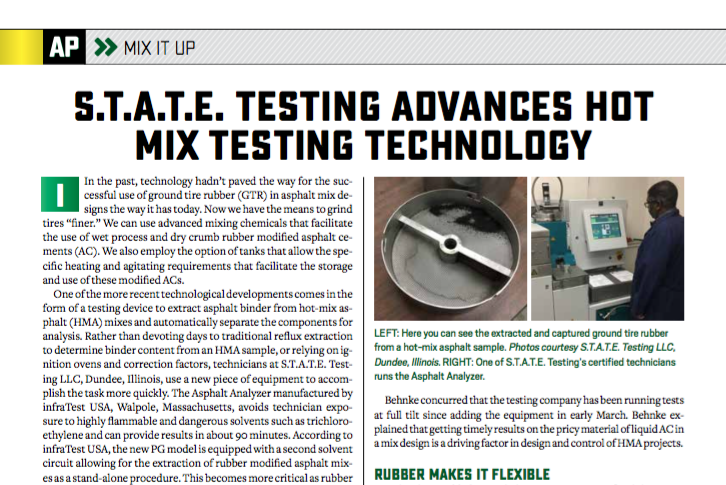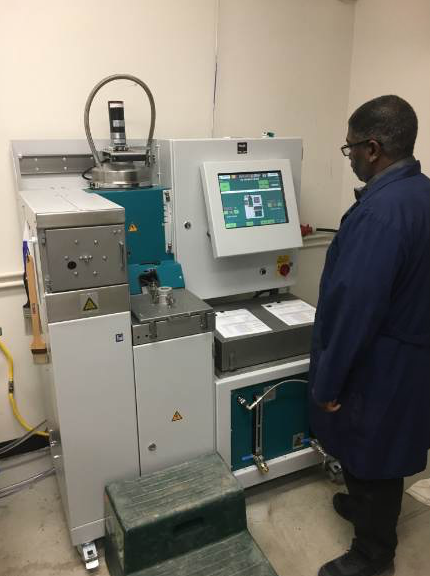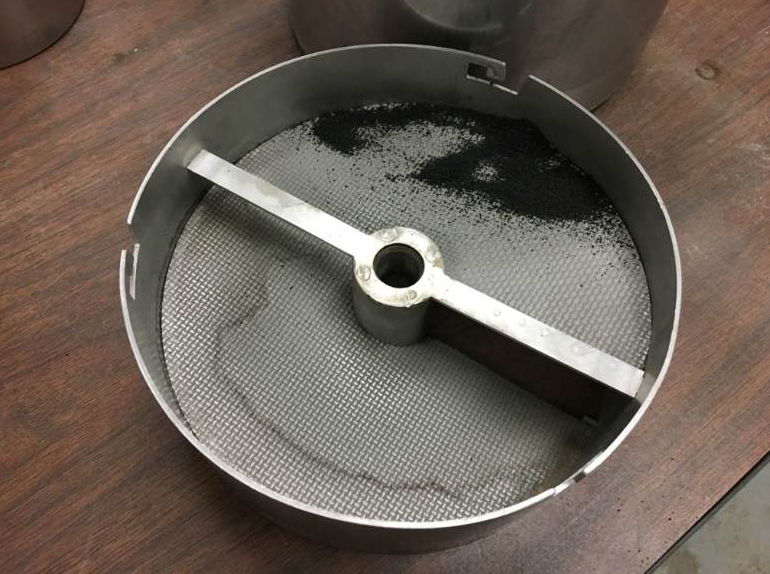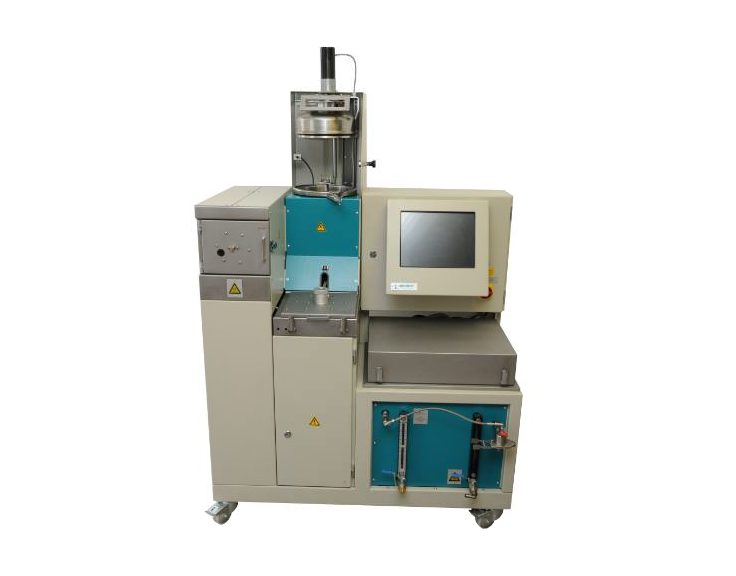S.T.A.T.E. Testing Advances Hot Mix Testing Technology
BY Sandy Lender

In the past, technology hadn’t paved the way for the successful use of ground tire rubber (GTR) in asphalt mix designs the way it has today. Now we have the means to grind tires “finer.” We can use advanced mixing chemicals that facilitate the use of wet process and dry crumb rubber modified asphalt cements (AC). We also employ the option of tanks that allow the specific heating and agitating requirements that facilitate the storage and use of these modified ACs.
One of the more recent technological developments comes in the form of a testing device to extract asphalt binder from hot-mix asphalt (HMA) mixes and automatically separate the components for analysis. Rather than devoting days to traditional reflux extraction to determine binder content from an HMA sample, or relying on ignition ovens and correction factors, technicians at S.T.A.T.E. Testing LLC, Dundee, Illinois, use a new piece of equipment to accomplish the task more quickly. The Asphalt Analyzer manufactured by infraTest USA, Walpole, Massachusetts, avoids technician exposure to highly flammable and dangerous solvents such as trichloroethylene and can provide results in about 90 minutes. According to infraTest USA, the new PG model is equipped with a second solvent circuit allowing for the extraction of rubber modified asphalt mixes as a stand-alone procedure. This becomes more critical as rubber use in pavements increases, and as new processes are implemented for incorporation of the rubber.
Test at Full Tilt

One of S.T.A.T.E. Testing’s certified technicians runs the Asphalt Analyzer.
S.T.A.T.E. Testing is a division of State Materials Engineering, and is an independent professional engineering firm specializing in consultation and testing of construction materials. President Jay Behnke, P.E., started the company in 1999 with the idea of providing engineering and materials testing services to both the highway and airport construction industry and public construction agencies. Its East Dundee and O’Hare labs are accredited by the American Association of State Highway and Transportation Officials (AASHTO). The technicians continue to upgrade their training, with many of them maintaining the highest degree recognized in Illinois.
In first quarter 2017, the firm added the PG model Asphalt Analyzer. Technical Director and Senior Engineer Joe Pitlik, P.E., said the machine has had an immediate impact on lab operations.
“We are still working on agency adoption and specification, which will drive the volume of testing, but it has had an immediate impact on our lab operations,” Pitlik said. “The ability to rapidly and reliably determine AC and dust in RAP, RAS and mixtures is a tremendous help. Also, as we work on specification development for binder grading of AC from field samples—including both virgin and recycled AC components—it really improves our ability to get samples over to the binder testing lab with minimal effort and minimizes the exposure to solvent.”
Behnke concurred that the testing company has been running tests at full tilt since adding the equipment in early March. Behnke explained that getting timely results on the pricy material of liquid AC in a mix design is a driving factor in design and control of HMA projects.
Rubber Makes it Flexible
GTR has been added to asphalt mixes to improve flexibility since the ’90s, however, the technology has improved over the last decade. GTR offers the advantage that it makes pavements less prone to both cracking and rutting. An HMA pavement needs to be strong enough to resist rutting under traffic but flexible enough to resist cracking caused by thermal and other stresses. Each property, rutting on one side and cracking on the other, can be assessed by S.T.A.T.E. Testing. The net effect of rubber, when used properly, is to stiffen the mix without sacrificing flexibility.

Here you can see the extracted and captured ground tire rubber from a hot-mix asphalt sample. Photos courtesy S.T.A.T.E. Testing LLC, Dundee, Illinois.
“We have the Hamburg Wheel Test that is very repeatable and relatable to field conditions to tell us whether a mix will or won’t rut or strip,” Behnke said. “Now we need to determine a test for cracking. In my opinion, the one that correlates to field conditions the most and is the most repeatable is the DCT.”
Behnke has great faith in the Disk-Shaped Compact Tension Test (DCT). The DCT is specified in ASTM D7313-(07) and is used to find the cracking point of asphalt mixes in either lab or field samples. The test is usually run at 10oC warmer than the low PG temperature point. For work in Illinois this generally means a target grade of PG XX-22 and a test temperature of -12°C (10.4°F).
Confirm It
Behnke explained that the Asphalt Analyzer PG model is important to the use of these new mixes because of the ability to separate out the rubber and confirm contents. Because we’re relying on the rubber to modify our asphalt, the agencies need to be able to confirm or verify the amounts of rubber. Every process is a little bit different. Whether it’s terminally or plant blended with a wet process or dry crumb rubber, agencies need to know that they are getting what they paid for.”
Whether the mix has rubber or a combination of polymer and crumb rubber, or some other modified combination, the Asphalt Analyzer PG model separates each component and the modified binder is deposited into its own container to be tested. Technicians can assess the new performance grade and the percentage of the mix the binder comprises with confidence.
Behnke explained that the Asphalt Analyzer has assisted them in discovering “hidden” percentage points of binder that other test methods may have been unable to find. For example, the binder trapped inside absorptive aggregate or aged fractionated RAP gets pulled out of the aggregate during the combination of centrifuge and reflux process of the analyzer. Using vacuum pressure, rather than heat to dry back the aggregate speeds the process without the potential to break down aggregate.
“We’re at the place we should be at and the binder was there in the mix all along; we just didn’t know it and couldn’t prove it,” Behnke said. “Now we can prove it.” While previously mixes may have been resulting in AC contents being 0.1 or 0.2 percent low, more of the mixes check out at optimum AC content.
Quality Pays

With the motto of “Quality is our stepping stone,” S.T.A.T.E. Testing is forging a path to assist agencies in obtaining high quality, high performing pavements. S.T.A.T.E. Testing performs verification testing for several agencies in the state including the Illinois Department of Transportation, the City of Chicago and the Illinois Tollway. S.T.A.T.E.
Testing is constantly involved in initiatives to improve quality such as the one they are involved with the National Highway Institute (NHI) on revamping its Transportation Construction Quality Assurance class.
Whether a sample to be tested comes from a S.T.A.T.E. Testing monitored project or a client’s project, the company stresses best practices for sampling and testing.
“Using proper procedures to select sample locations, and then best practice to actually perform sampling and testing is absolutely critical,” Pitlik shared. “The data is only as good as the means used to collect it. Proper lab accreditation and adherence to test standards are critical. Avoiding even the potential for bias is key to keeping the job in the engineer’s office and out of a lawyer’s office.”
Handling samples in an ethical manner shouldn’t be a practice just to avoid litigation; good QC/QA affects the contractor’s pay scale.
“As we move toward payment systems with incentives and disincentives, more and more challenges will be mounted and both the contractor and the owner need to be prepared to defend their results,” Pitlik finished.
S.T.A.T.E. Testing is currently installing two infraTest Asphalt Analyzers (one with rubber chamber and one without) for IDOT districts in Chicagoland and Peoria.
